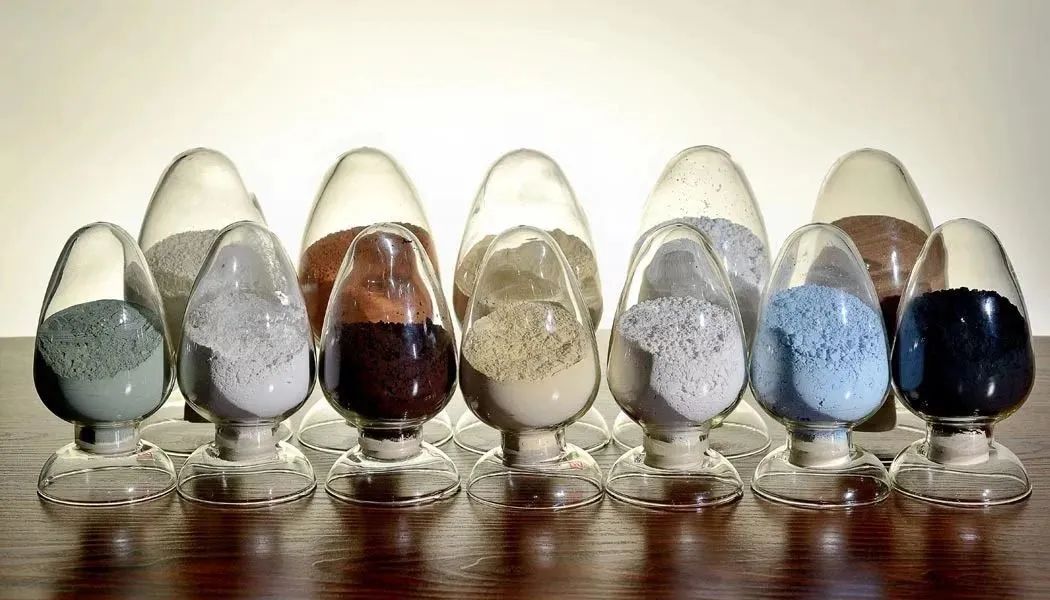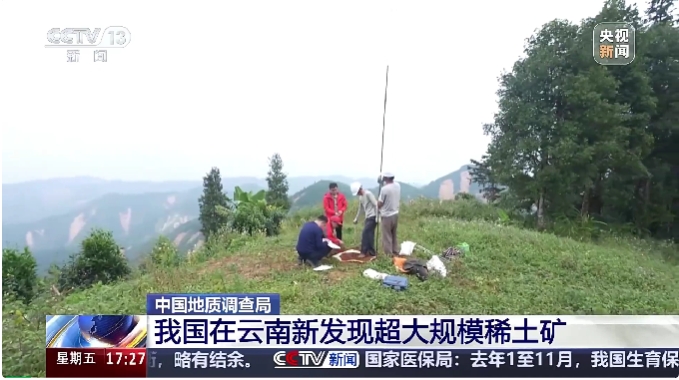A major breakthrough in rare earths.
According to the latest news, the China Geological Survey under the Ministry of Natural Resources of China has discovered a super-large-scale ion-adsorption rare earth mine in the Honghe area of Yunnan Province, with potential resources of 1.15 million tons. This is another major breakthrough in China’s ion-adsorption rare earth prospecting since the first discovery of ion-adsorption rare earth mines in Jiangxi in 1969, and is expected to become China’s largest medium and heavy rare earth deposit.
Medium and heavy rare earths are more valuable than light rare earths due to their high value and small reserves. They are strategically significant mineral resources with a wider range of applications. They are essential key raw materials for electric vehicles, new energy, national defense security, etc., and are key metals for the development of high-tech industries.
Institutional analysis believes that on the demand side, the demand side of the rare earth industry chain is expected to pick up under the multiple catalysts of new energy vehicles, wind power, home appliances, industrial robots, etc. With the bottoming out of rare earth prices, the supply and demand pattern continues to improve, and the rare earth industry may be expected to start a big year of growth in 2025.
Major breakthrough
On January 17, according to The Paper, the China Geological Survey of the Ministry of Natural Resources of China learned that the department discovered a super-large-scale ion-adsorption rare earth mine in the Honghe area of Yunnan Province, with potential resources of 1.15 million tons.
The total amount of core rare earth elements such as praseodymium, neodymium, dysprosium, and terbium rich in the deposit exceeds 470,000 tons.
This is another major breakthrough in China’s ion-adsorption rare earth prospecting after the first discovery of ion-adsorption rare earth mines in Jiangxi in 1969, and it is expected to become China’s largest medium and heavy rare earth deposit.
Analysts believe that this discovery is of great significance to consolidating China’s rare earth resource advantages and improving the rare earth industry chain, and will further consolidate China’s strategic advantages in the field of medium and heavy rare earth resources.
The ion-adsorption rare earth mines discovered this time are mainly medium and heavy rare earth mines. China is rich in light rare earth resources, mainly distributed in Baiyunebo, Inner Mongolia and Yaoniuping, Sichuan, etc., but medium and heavy rare earth resources are relatively scarce and have a wider range of applications. They are essential key raw materials for electric vehicles, new energy, national defense security, etc., and are key metals for the development of high-tech industries.
The China Geological Survey has combined geological surveys with scientific research. Through more than 10 years of work, it has established a national geochemical benchmark network, obtained massive geochemical data, and made important breakthroughs in prospecting theory and exploration technology, filling the gap in geochemical exploration technology for ion adsorption rare earth mines, and established a rapid, accurate, and green exploration technology system, which is of great reference significance for China’s other medium and heavy rare earth-rich areas to achieve rapid breakthroughs in prospecting.
Strategic significance of medium and heavy rare earths

Rare earths refer to the general term for elements such as lanthanum, cerium, praseodymium, neodymium, promethium, samarium, europium, gadolinium, terbium, dysprosium, holmium, erbium, thulium, ytterbium, lutetium, scandium, and yttrium.
According to the atomic electron layer structure and physical and chemical properties of rare earth elements, as well as their symbiosis in minerals and the characteristics of different properties produced by different ion radii, the seventeen rare earth elements can be divided into two categories: light rare earths and medium and heavy rare earths. Medium and heavy rare earths are more valuable than light rare earths due to their high value and small reserves.
Among them, heavy rare earths are mineral resources of great strategic significance, but the mineralization type of heavy rare earths is single, mainly ion adsorption type, and the environmental problems in its mining process (in situ leaching) are prominent, so finding new types of heavy rare earth deposits is an important scientific exploration.
my country is the country with the highest rare earth reserves in the world and the country with the highest rare earth mining volume in the world. According to the United States Geological Survey (USGS) report, China’s rare earth production in 2023 will reach 240,000 tons, accounting for about two-thirds of the world’s total, and its reserves will reach 44 million tons, accounting for 40% of the world’s total. The report also shows that China produces 98% of the world’s gallium and 60% of the world’s germanium; from 2019 to 2022, 63% of the antimony ore and its oxides imported by the United States came from China.
Among them, permanent magnet materials are the most important and most promising downstream application field of rare earths. The most widely used rare earth permanent magnet material is neodymium iron boron permanent magnet material, which has excellent properties such as light weight, small size, high magnetic energy product, good mechanical properties, convenient processing, high yield, and can be magnetized after assembly. High-performance neodymium iron boron permanent magnet materials are mainly used in wind turbines, energy-saving variable frequency air conditioners, energy-saving elevators, new energy vehicles, industrial robots, etc.
According to the analysis, on the demand side, the demand side of the rare earth industry chain is expected to pick up under multiple catalysis such as new energy vehicles, wind power, home appliances, and industrial robots.
Specifically, with the rapid growth in sales of new energy vehicles and the continuous improvement in penetration, the demand for drive motors represented by permanent magnet motors, one of the core components of new energy vehicles, will be boosted, thereby driving the growth in demand for rare earth permanent magnet materials. Humanoid robots have become a new development track, which is expected to further open up long-term growth space for rare earth permanent magnet materials. In addition, in addition to the continued growth in demand for new energy vehicles and industrial robots, it is expected that demand in the wind power industry will see marginal improvement in 2025.
How to look at the market outlook
Institutional analysis believes that with the bottoming out of rare earth prices and the continuous improvement of the supply and demand pattern, the rare earth industry may be expected to start a big year of growth in 2025.
Guotai Junan Securities pointed out that as domestic rare earth indicators shift from a strong supply release cycle to a supply constraint pattern, coupled with the large increase in overseas plans but slow actual growth, the effectiveness of supply-side constraints has begun to show. The demand for new energy vehicles and wind power continues to grow, and the demand for equipment renewal of industrial motors has effectively raised the demand curve from 2025 to 2026, which may take over from new energy and become an important source of demand growth for rare earths; coupled with the expansion of application scenarios for robots, 2025 may once again usher in a big year for the growth of rare earth magnetic materials.
Guojin Securities said that since 2024, rare earth prices have experienced a bottoming out. Under the background of significantly strengthened expectations for supply and demand improvement and the catalysis of the “quasi-supply reform” policy, commodity prices have risen by nearly 20% from the bottom, and the price center of gravity has gradually risen; the rare earth management regulations have been implemented since October 1, 2024 to compress supply, and the peak season orders in the fourth quarter are gradually being fulfilled. Combined with the upward trend of the industry cost curve and frequent supply disturbances, rare earth prices continue to rise, and related concept stocks will usher in opportunities for fundamental bottoming out and value revaluation under the “quasi-supply reform” policy.
Recently, Baosteel Co., Ltd., a rare earth giant, issued an announcement stating that according to the calculation formula and the market price of rare earth oxides in the fourth quarter of 2024, the company plans to adjust the price of related transactions of rare earth concentrates in the first quarter of 2025 to 18,618 yuan/ton (dry weight, REO=50%) excluding tax, and the price excluding tax will increase or decrease by 372.36 yuan/ton for every 1% increase or decrease in REO. Compared with the rare earth concentrate transaction price of 17,782 yuan/ton in the fourth quarter of 2024, it increased by 836 yuan/ton, a month-on-month increase of 4.7%.
After the Northern Rare Earth Plan canceled the listing price, the adjustment of its quarterly rare earth concentrate-related transaction price with Baosteel became the industry’s weathervane. Ding Shitao of Guolian Securities predicts that the supply and demand pattern is expected to continue to improve from 2025 to 2026, and is optimistic about the confirmation of the bottom of the rare earth boom in 2024, and rare earth is expected to reshape a new cycle in 2025.
CITIC Securities also believes that rare earths are expected to usher in a more certain rebound in the second half of 2025, and emerging fields such as AI and robots are expected to remain active.
Post time: Jan-22-2025
